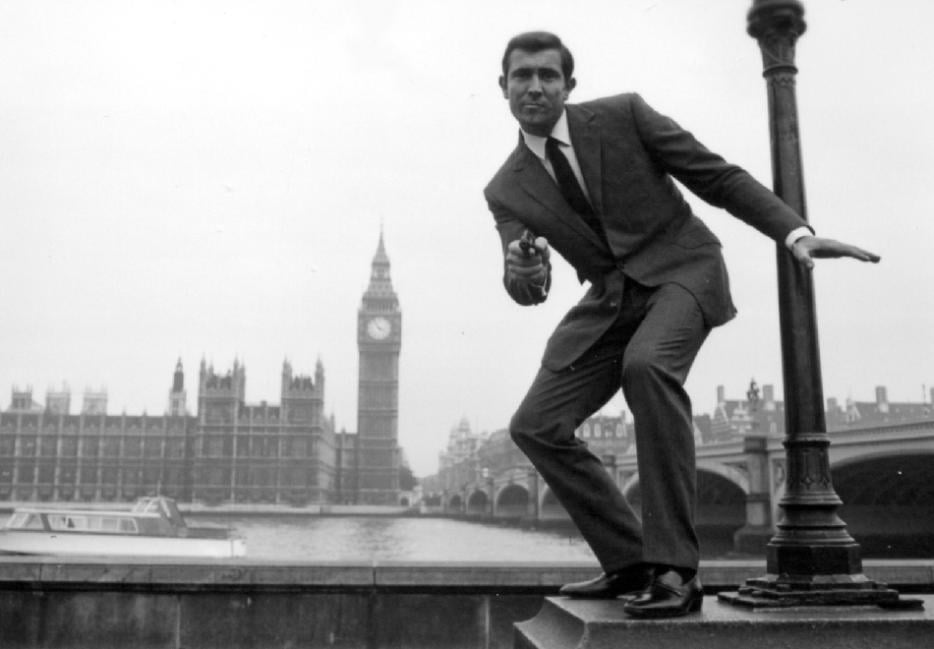I.
‘A motorist brought him in getting on for half an hour ago. Said he found him wandering about in the road near one of the entrances to the Great Park. Of course, we thought he was tight at first.’
‘There’s a similarity. The quiet kind of drink. I can’t think of any better way of making a man docile. You know, sergeant, there’s something nasty about this, whatever it is. Who is our friend?’
‘Name of Bond, James Bond. Business address in London, Regent’s Park somewhere.’
A well-connected banking heir, Ian Fleming turned to writing as yet another hobby. His first novel, Casino Royale, was written over a few weeks at his estate in Jamaica, drawing on his experience as an intelligence officer in the Second World War. It was published in 1953. Fleming introduced his main character without much ceremony or grace: “James Bond suddenly knew that he was tired. He always knew when his body or his mind had had enough and he always acted on the knowledge.”
By 1957, thanks in part to a serialization in the Daily Express, Bond was a household name in Britain. When President Kennedy listed From Russia With Love as one of his ten favourite books in an article for Life, sales spiked and Bond exploded into the American consciousness. Contemporary critics appear unable to overstate the series’ influence—two recent book-length treatments are titled The Man Who Saved Britain and The James Bond Phenomenon.
Now, we tend to think about James Bond as biennial film appointment—another chance to sell explosions and Omega watches to 13-year-old boys, even though today’s Bond fans are typically men over 35. Fair enough. MGM estimates that over half the world has seen a Bond film. But the character was a literary “phenomenon” before Sean Connery sipped his first celluloid martini, and the Bond novels have never gone out of print — with one exception. Colonel Sun, published in 1968, was the first novel in the series written by someone other than Fleming, and has been unavailable since the early 1990s. But Vintage Classics is bringing it back to shelves on November 24th.11Vintage Classics is, like Hazlitt, a property of Penguin Random House.
II.
It is true that a secret agent on an assignment must never fall into any kind of routine that will enable the opposition to predict his movements, but it was not until later that Bill Tanner was to appreciate the curious unintentional significance of what Bond was saying.
“I don’t quite follow, James. It doesn’t apply to your life in England, surely,” said Tanner, speaking with equally unintentional irony.
“I was thinking of the picture as a whole. My existence is falling into a pattern. I must find some way of breaking out of it.”
As the Bond novels were first captivating readers, Kingsley Amis was rising to the top of the British literary world. He had started his debut novel, Lucky Jim, while working in a dreary university in Wales after failing his graduate work at Oxford. “What am I doing here? Or anywhere, for that matter” he wrote to Philip Larkin. He channeled his provincial frustrations into a potent and occasionally poetic mix of sex, class and irony, scandalizing readers and charming critics. Lucky Jim brought Amis the Somerset Maugham Award in 1955, and an uncommon celebrity for a novelist. Picture Jonathan Franzen with a better sense of humour, a more concise Donna Tartt.
But Amis was still bored. He drifted from post to post, teaching creative writing, but felt stifled by convention. After four more novels, he had exhausted the fiction that had brought him fame. He told the Daily Mail, “I don’t want to do documentary realism any more. In England one is supposed to be a writer about Britain in the ’50s and ’60s. I don’t want to write that kind of book.” He started working on a piece about spy thrillers, hoping it would be published by the New Yorker. It became a book-length critical treatment, The James Bond Dossier, an exhaustive survey of all twelve novels in the series. “Most secret agents of the mind, I should think, take advantage of the chief characteristic of real secret agents. Not only have the latter no need to be outwardly different from other men; they must not be different. So our fantasist can say to himself whenever he feels like it and without any special preparation: Under this fiendishly clever bank-clerk (etc.) disguise lurks intrepid ruthless 00999.”
Fleming loved Amis’s analysis, and when he died in 1964, Amis was asked to consult on his unfinished manuscript for The Man with the Golden Gun. The publisher ignored Amis’s suggestions for that book, but he was hired to write the next installment, Colonel Sun, under the pseudonym Robert Markham. There were immediate concerns about fit. “In the preliminary stages, fears were expressed in some quarters that I might produce a sort of Lucky Jim Bond, rampaging through the back streets of Wigan with a packet of fish and chips in one hand and a broken beer bottle in the other.”
The novel confirmed many suspicions. Writing for The Guardian, Malcolm Bradbury was brief: “what happens is that the famous exotic world of Fleming gets cut down uncomfortably to size by the equally famous world of the Amis reality principle.” Amis, for his part, thought that the Sean Connery movies were largely to blame for this chilly reception. As noted in A New James Bond, he wrote that his Bond “does rather more thinking than his predecessor normally went in for. But the contrast is much, much more with the Bond of the films, that wisecracking dandy with a personal jet-pack or mini-H-bomb constantly within reach.”
III.
Perhaps Amis’s struggles point to a larger, stranger cultural history. The first movie I remember going to—not, like, sitting in a theatre watching a movie, that’s Aladdin—but my first memory of the going to a theatre is of going to see Tomorrow Never Dies. The second Bond movie with Pierce Brosnan in the lead, in which Jonathan Pryce plays a Steve Jobs/Rupert Murdoch pastiche trying to orchestrate a world war worthy of his global media company. Here is some real dialogue from that movie:
“Mr. Jones, are we ready to release our new software?”
“Yes sir, as requested it’s full of bugs, which means people will be forced to upgrade for years.”
“Outstanding.”
My uncle and his sons had driven from Markham to my parents’ house, and we walked to the old two-screen on Bloor Street, the Runnymede. It was, at most, a beautiful fifteen-minute walk away. I remember it because my family spent the whole time complaining about walking. We should have driven to the theatre. James Bond, my cousins reasoned, would have driven. It’s a very male memory, and it was a terrible movie, they explained to me, compared to the sublime perfection of the Connery films. We took the subway home, one stop.
2015 is the thirtieth anniversary of a spectacular cultural event. Not A View to a Kill, the last Bond film to star Roger Moore, who, at 58, was a frighteningly avuncular sex symbol. It’s the anniversary Eve Sedgwick’s Between Men, her first book, an exploration of male friendship and more-than-friendship across nearly three hundred years of English literature.
Sedgwick’s most transportable concept, adapted from René Girard (who passed away last week), was the idea that straight-ish men redirect their feelings for each other through competition. “The bond that links two rivals is as intense and potent as the bond that links either of the rivals to the beloved.” We see this structure throughout the Bond books and films, used as a reliable method of raising the stakes. Bond seduces a woman close to his adversary and then she is killed, legitimating the intensity of Bond’s hatred. We see it as early as Jill Masterton in Goldfinger, and as recently as Severine No-last-name (played by Bérénice Marlohe) in Skyfall. These murders are used define these villains as men—well, as a type of man. Guy Burgess casts a long shadow over Fleming’s idea of evil.
Amis doesn’t use women as a ligature between Bond and his Colonel Sun, and although Bond picks up a woman working for the Soviets during the mission, we might admire the absence of paternalistic sentiment. She is treated as another operative, cognizant of the risks and acting for herself. Instead, Amis’s Bond worries about being a bad role model. “He hoped desperately that the relative unsophistication of Greek youth would protect Yanni from the progressive intoxication with lethal weapons that, in an urban British lad of this age, could so easily result from such an episode.” We should detect a few fresh layers of racist condescension in this passage, but I can’t help but see Amis making a comment on all of the fathers who would identify with Bond, bringing their sons the theatre.
IV.
Here we are, James, the two of us in a cellar on a Greek island. Not a very lavish scene, I’m afraid, such as some of your earlier opponents have provided. But then you and I aren’t opponents, are we? We’re collaborators. Right, then. What shall I do to you? Whereabouts in your body shall I attack you? And with what?
- Colonel Sun
Amis’s novel fully breaks down—at least, according to convention—by refusing to build this reliable triangle. Instead, Amis’s titular villain unambiguously wants an intense relationship with Bond and Bond alone. Colonel Sun substitutes torture for “that sickening and mysterious intimacy that gradually comes to unite prisoner and interrogator.” He quotes De Sade as he drives a steel rod into Bond’s ear: “Through cruelty one rises to heights of superhuman awareness, of sensitivity to new modes of being … Side by side you and I will explore the heights.”
In his preface to The James Bond Dossier, Amis wrote that he couldn’t “help being slightly drawn to any form of writing that (like science fiction) reaches no part of its audience through compulsion,” particularly after teaching. Not simply finding pleasure in text, but reading text for which pleasure is the primary motivation. Amis wanted to clarify the nature of this pleasure. In an appendix titled “Sadism” he worries about “the basic point … of enjoyment: does the author evidently feel, is the reader invited to feel, that this, that, or the other beating or stabbing or throttling is fun and put there for fun?”
Bond escapes, of course, and Sun apologizes for being a careless reader in their final confrontation:
I want to tell you now that what I said to you earlier was quite wrong. De Sade misled me. Or I didn’t read him properly. I didn’t feel like a god when I was torturing you back there. I felt sick and guilty and ashamed. I behaved in an evil and childish way. It’s ridiculous and meaningless, but I want to apologize. Can you forgive me?
It doesn’t seem like a difficult jump to imagine Colonel Sun as the wrong kind of Bond fan—the one who reads the novels and watches the movies for the thrill of the violence.
V.
As they moved off, Bond glanced down at the corpse of the man whose death he had unwittingly brought about. It lay there waiting to be removed and disposed of according to routine, a piece of debris, totally insignificant. Bond hated and feared the half-revealed purpose that had brought the man to this house, but he could not repress a twinge of pity at the thought of the casual chance that had led to this summary removal. Was this how James Bond would end, shot in the head and flung aside like a heap of unwanted clothing to smooth out a kink in somebody’s plan?
The essayist and critic Wayne Koestenbaum, in a lecture marking the anniversary of Between Men, praised Sedgwick for “challenging our ideas about matters that formerly provoked derisive laughter or shaming silence.” Koestenbaum succinctly identifies her linked programs of diversity and acceptance—Sedgwick’s analysis opened the door for other, new, different, even buried reactions, and implied that a lack of empathy was both a moral and an intellectual failure.
The first Bond movie after Amis’s book—On Her Majesty’s Secret Service, the only film to star George Lazenby—resurrects triangular competition, but through metafiction. In the opening sequence, we watch through crosshairs as a woman in a kaftan walks herself out to sea, presumably to commit suicide. Bond, we learn, is the rifleman. He puts the gun back into its velvet case and sprints down to the beach, saves her life, and as he is providing mouth-to-mouth resuscitation, is attacked by two knife-wielding toughs. As Bond and the assaillants tousle, the woman runs to Bond’s car and drives away, leaving him alone on the beach. The camera closes in on an insouciant Lazenby: “This never happened to the other fellow.”
Of course, Amis hated the film.






